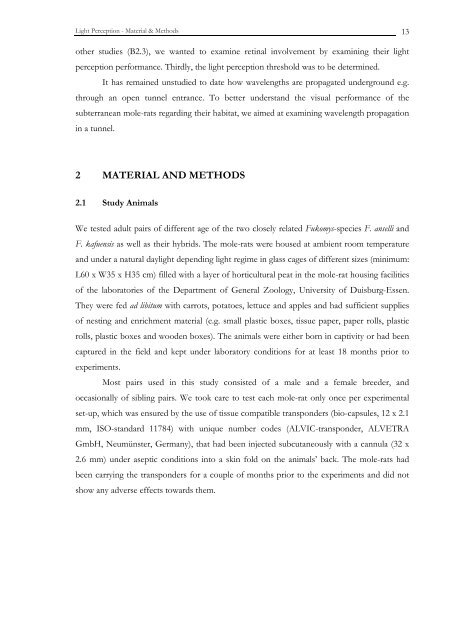Antigen Biotinylated Anti-Rabbit lgs Rabbit Primary Antiserum AB ...
Antigen Biotinylated Anti-Rabbit lgs Rabbit Primary Antiserum AB ...
Antigen Biotinylated Anti-Rabbit lgs Rabbit Primary Antiserum AB ...
Create successful ePaper yourself
Turn your PDF publications into a flip-book with our unique Google optimized e-Paper software.
Light Perception - Material & Methods<br />
other studies (B2.3), we wanted to examine retinal involvement by examining their light<br />
perception performance. Thirdly, the light perception threshold was to be determined.<br />
It has remained unstudied to date how wavelengths are propagated underground e.g.<br />
through an open tunnel entrance. To better understand the visual performance of the<br />
subterranean mole-rats regarding their habitat, we aimed at examining wavelength propagation<br />
in a tunnel.<br />
2 MATERIAL AND METHODS<br />
2.1 Study Animals<br />
We tested adult pairs of different age of the two closely related Fukomys-species F. anselli and<br />
F. kafuensis as well as their hybrids. The mole-rats were housed at ambient room temperature<br />
and under a natural daylight depending light regime in glass cages of different sizes (minimum:<br />
L60 x W35 x H35 cm) filled with a layer of horticultural peat in the mole-rat housing facilities<br />
of the laboratories of the Department of General Zoology, University of Duisburg-Essen.<br />
They were fed ad libitum with carrots, potatoes, lettuce and apples and had sufficient supplies<br />
of nesting and enrichment material (e.g. small plastic boxes, tissue paper, paper rolls, plastic<br />
rolls, plastic boxes and wooden boxes). The animals were either born in captivity or had been<br />
captured in the field and kept under laboratory conditions for at least 18 months prior to<br />
experiments.<br />
Most pairs used in this study consisted of a male and a female breeder, and<br />
occasionally of sibling pairs. We took care to test each mole-rat only once per experimental<br />
set-up, which was ensured by the use of tissue compatible transponders (bio-capsules, 12 x 2.1<br />
mm, ISO-standard 11784) with unique number codes (ALVIC-transponder, ALVETRA<br />
GmbH, Neumünster, Germany), that had been injected subcutaneously with a cannula (32 x<br />
2.6 mm) under aseptic conditions into a skin fold on the animals’ back. The mole-rats had<br />
been carrying the transponders for a couple of months prior to the experiments and did not<br />
show any adverse effects towards them.<br />
13

















